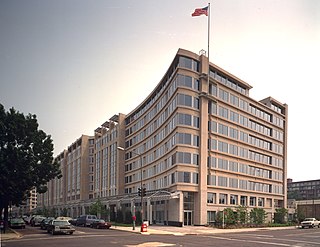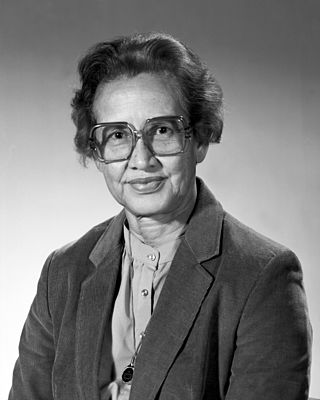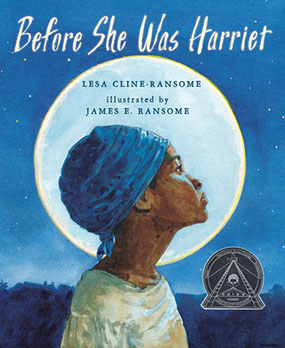
The term "computer", in use from the early 17th century, meant "one who computes": a person performing mathematical calculations, before electronic computers became commercially available. Alan Turing described the "human computer" as someone who is "supposed to be following fixed rules; he has no authority to deviate from them in any detail." Teams of people, often women from the late nineteenth century onwards, were used to undertake long and often tedious calculations; the work was divided so that this could be done in parallel. The same calculations were frequently performed independently by separate teams to check the correctness of the results.

The Mary W. Jackson NASA Headquarters is a low-rise office building in the two-building Independence Square complex at 300 E Street SW in Washington, D.C. The building houses NASA leadership who provide overall guidance and direction to the US government executive branch agency NASA, under the leadership of the NASA administrator. Ten field centers and a variety of installations around the country conduct the day-to-day work.

Creola Katherine Johnson was an American mathematician whose calculations of orbital mechanics as a NASA employee were critical to the success of the first and subsequent U.S. crewed spaceflights. During her 33-year career at NASA and its predecessor, she earned a reputation for mastering complex manual calculations and helped pioneer the use of computers to perform the tasks. The space agency noted her "historical role as one of the first African-American women to work as a NASA scientist".

Christine Darden is an American mathematician, data analyst, and aeronautical engineer who devoted much of her 40-year career in aerodynamics at NASA to researching supersonic flight and sonic booms. She had an M.S. in mathematics and had been teaching at Virginia State University before starting to work at the Langley Research Center in 1967. She earned a Ph.D. in engineering at George Washington University in 1983 and has published numerous articles in her field. She was the first African-American woman at NASA's Langley Research Center to be promoted to the Senior Executive Service, the top rank in the federal civil service.
African-American women in computer science were among early pioneers in computing in the United States, and there are notable African-American women working in computer science.
The role of women in and affiliated with NASA has varied over time. As early as 1922 women were working as physicists and in other technical positions.[1] Throughout the 1930s to the present, more women joined the NASA teams not only at Langley Memorial, but at the Jet Propulsion Laboratory, the Glenn Research Center, and other numerous NASA sites throughout the United States.[2] As the space program has grown, women have advanced into many roles, including astronauts.
The West Computers were the African American, female mathematicians who worked as human computers at the Langley Research Center of NACA from 1943 through 1958. These women were a subset of the hundreds of female mathematicians who began careers in aeronautical research during World War II. To offset the loss of manpower as men joined the war effort, many U.S. organizations began hiring, and actively recruiting, more women and minorities during the 1940s. In 1935, the Langley Research Center had five female human computers on staff. By 1946, the Langley Research Center had recruited about 400 female human computers.

Dorothy Jean Johnson Vaughan was an American mathematician and human computer who worked for the National Advisory Committee for Aeronautics (NACA), and NASA, at Langley Research Center in Hampton, Virginia. In 1949, she became acting supervisor of the West Area Computers, the first African-American woman to receive a promotion and supervise a group of staff at the center.

Hidden Figures is a 2016 American biographical drama film directed by Theodore Melfi and written by Melfi and Allison Schroeder. It is loosely based on the 2016 non-fiction book of the same name by Margot Lee Shetterly about three female African-American mathematicians: Katherine Goble Johnson, Dorothy Vaughan, and Mary Jackson, who worked at NASA during the Space Race. Other stars include Kevin Costner, Kirsten Dunst, Jim Parsons, Mahershala Ali, Aldis Hodge, and Glen Powell.

Last Stop on Market Street is a 2015 children's book written by American author Matt de la Peña and illustrated by Christian Robinson, which won the 2016 Newbery Medal, a Coretta Scott King Illustrator Honor, and a Caldecott Honor. The book follows a young boy named CJ as he learns to appreciate the beauty in everyday things during a bus ride. De la Peña and Robinson both drew on personal experiences when working together to create the book. Through its story and illustrations, Last Stop on Market Street tackles issues of race and class as they may be seen through the eyes of a young teen. Last Stop on Market Street was met with widespread acclaim after its release, receiving positive reviews from Kirkus Reviews and the New York Times Book Review amongst many others. Last Stop on Market Street's Newbery win was monumental, as it is extremely rare for picture books to be awarded this medal. In 2018, the children's book was adapted into a children's musical which has been performed by various children's theater groups across the country.

Margot Lee Shetterly is an American nonfiction writer who has also worked in investment banking and media startups. Her first book, Hidden Figures: The American Dream and the Untold Story of the Black Women Who Helped Win the Space Race (2016), is about African-American women mathematicians working at NASA who were instrumental to the success of the United States space program. She sold the movie rights while still working on the book, and it was adapted as a feature film of the same name, Hidden Figures (2016). For several years Shetterly and her husband lived and worked in Mexico, where they founded and published Inside Mexico, a magazine directed to English-speaking readers.

Mary Jackson was an American mathematician and aerospace engineer at the National Advisory Committee for Aeronautics (NACA), which in 1958 was succeeded by the National Aeronautics and Space Administration (NASA). She worked at Langley Research Center in Hampton, Virginia, for most of her career. She started as a computer at the segregated West Area Computing division in 1951. In 1958, after taking engineering classes, she became NASA's first black female engineer.

Hidden Figures: The American Dream and the Untold Story of the Black Women Who Helped Win the Space Race is a 2016 nonfiction book written by Margot Lee Shetterly.

Dorothy Estheryne McFadden Hoover was an American physicist and mathematician. Hoover was a pioneer in the early days of NASA. Originally one of the first black women hired at Langley as a human computer, Hoover would eventually become a published physicist and mathematician. Hoover is one of the first black women to be listed as a co-author on NASA research publications. Her research supported the development of America's first jet fighter, the Sabre. Hoover's accomplishments were featured in Margot Lee Shetterly's bestselling book, Hidden Figures.

Before She Was Harriet is a 2017 children's picture book written by Lesa Cline-Ransome and illustrated by James Ransome, first published by Holiday House. It was awarded an honorary Coretta Scott King Award in 2018.

The "Rocket Girls" were the women that worked at NASA and the Jet Propulsion Laboratory (JPL) before the development of desktop computers. These women are mostly unknown, but they did the majority of all hand calculations for missions. Most of these women were given the nickname of "computers" due to their abilities in the fields of physics and mathematics.
Bonnie Kathaleen Land was a computer and mathematician at NASA's Langley facility. The 2016 movie Hidden Figures, which brought awareness to this early success within the NASA space program, was written by Land's former Sunday school student, and Land served as one of the first interviewees during research for the novel. Land was called the "inspiration behind, catalyst for, and gateway to" the creation of Hidden Figures.
Laura Freeman is a children's book illustrator. She received her BFA from the School of Visual Arts in New York City. She has illustrated many books, and done work for Highlights for Children. In a review of the picture book version of Hidden Figures, writing for School Library Journal, Megan Kilgallen said "Freeman’s full-color illustrations are stunning and chock-full of details, incorporating diagrams, mathematical formulas, and space motifs throughout... enhancing the whole book." She shared the 2019 NAACP Image Award for Outstanding Literary Work: Children with writer Margot Lee Shetterly for Hidden Figures.

Miriam Daniel Mann (1907–1967) was one of the first Black female computers for the National Advisory Committee for Aeronautics (NACA).

Kathryn Peddrew was an African-American mathematician, engineer, and scientist who played a crucial role in the National Advisory Committee for Aeronautics (NACA) and the National Aeronautics and Space Administration (NASA). She was one of the African-American women who worked as a "human computer" at NACA's Langley Research Center in the 1940s and 1950s.















